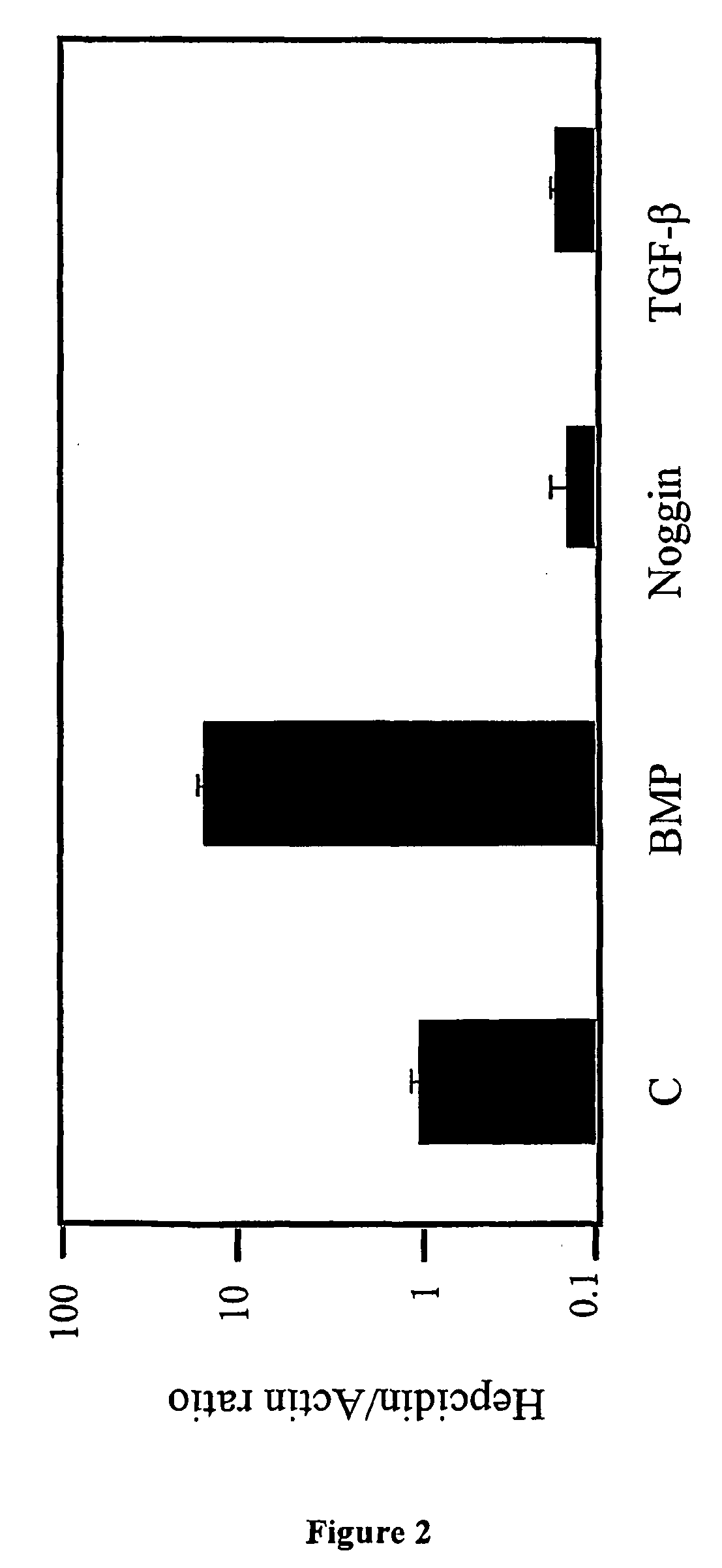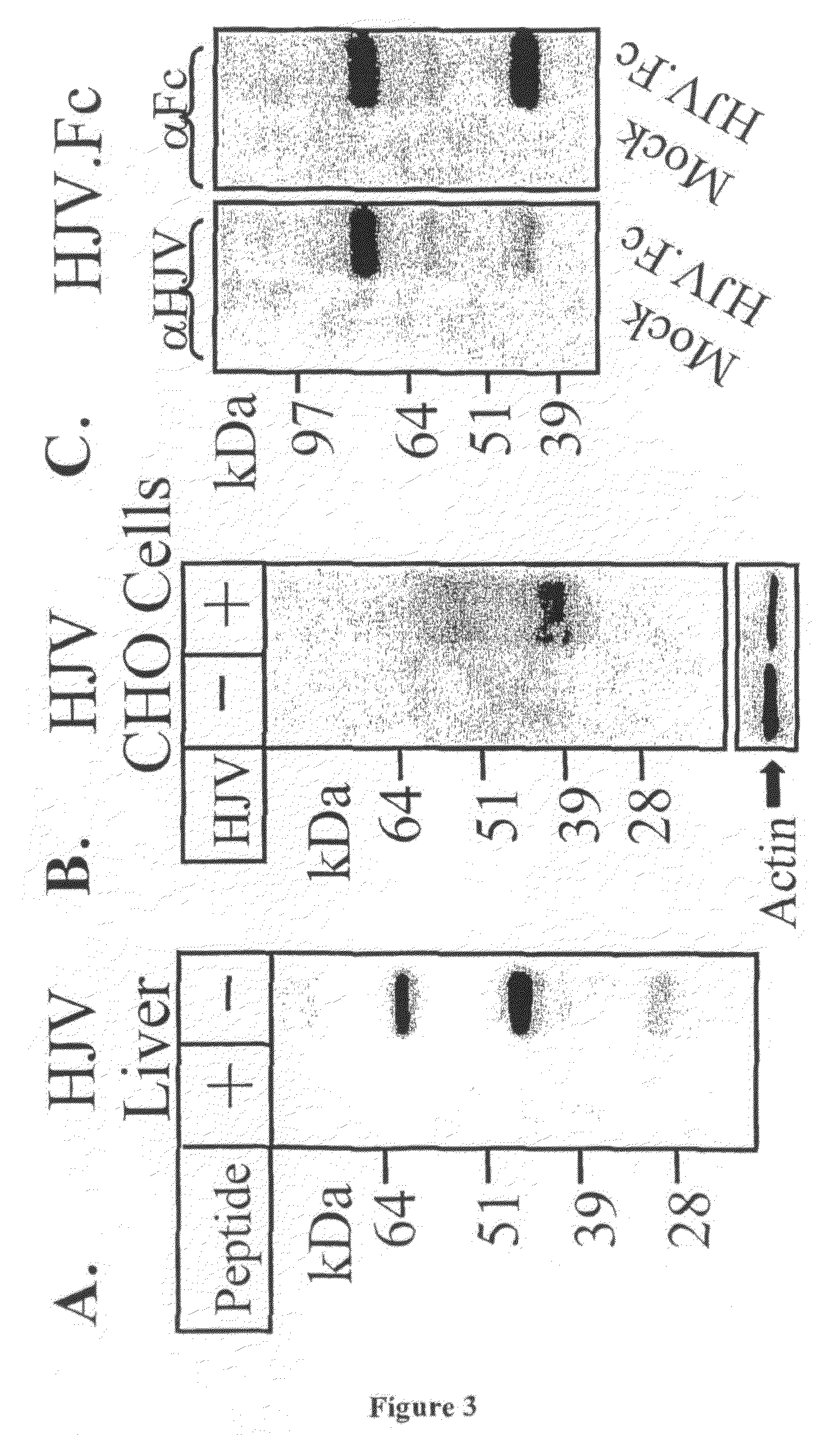Methods and compositions to regulate iron metabolism
a technology of iron metabolism and compositions, applied in the field of methods and compositions to regulate iron metabolism, can solve the problems of iron overload, iron can also be toxic, damage to iron accumulation in tissues, etc., and achieve the effect of less likely to induce undesirable side effects
- Summary
- Abstract
- Description
- Claims
- Application Information
AI Technical Summary
Benefits of technology
Problems solved by technology
Method used
Image
Examples
example 1
Effects of BMP and TGF-β on Hepcidin Transcription in Liver Cells
[0134]Study Protocol. The effects of BMP-2, Noggin (a well-known BMP inhibitor), and TGF-β1 on hepcidin mRNA expression in HepG2 liver hepatoma cells were studied and quantitated using real-time quantitative RT-PCR.
[0135]HepG2 cells (ATTC Number HB-8065) were grown in α-MEM (Minimal Essential Medium Alpha Medium with L-Glutamine supplemented with 10% fetal bovine serum, 100 U / mL penicillin and 100 μg / mL streptomycin) to 60% confluence on 6 cm tissue culture plates. Cells were then incubated in low-serum conditions (α-MEM with 1% FBS), with 1 μg / mL Noggin.Fc (R & D Systems, Minneapolis, Minn.) at 37° C. for 48 hours, or serum-starved for 6 hours followed by incubation with 50 ng / mL BMP-2 (R & D Systems) at 37° C. for 16 hours, or with 1 ng / mL TGF-β1 (R & D Systems) at 37° C. for 16 hours. Alternatively, cells were incubated at 37° C. for 72 hours with non-transferrin-bound iron (65 μM Fe-NTA). Fe-NTA was generated by co...
example 2
HJV.Fc Protein as Modulator of Hepcidin Expression
[0140]Juvenile hemochromatosis is a severe variant of hemochromatosis caused by mutations in two genes that give indistinguishable phenotypes. One gene encodes hepcidin (HAMP, 19q13.1). The second gene has recently been identified as hemojuvelin (HJV, 1q21). Although the function of HJV is unknown, hepcidin levels are depressed in persons with HJV mutations, indicating that HJV may be a modulator of hepcidin expression. As already mentioned herein, HJV is also a member of the repulsive guidance molecule (RGM) family of proteins, including RGMa and DRAGON, neuronal adhesion molecules which were recently shown by the present Applicants to function as a BMP co-receptor (J. L. Babitt et al., J. Biol. Chem., 2005, 280: 29820-29827; T. A. Samad et al., J. Biol. Chem., 2005, 280: 14122-14129, each of which is incorporated herein by reference in its entirety). The study presented below was undertaken to investigate whether HJV could similarl...
example 3
Effects of BMP-2 on Iron Binding Capacity In Vivo
[0172]Study Protocol. Normal mice were injected intraorbitally with 18 μg of BMP-2 (equivalent to 1 mg per kg body weight), or with carrier solution as a control. After 4 hours, blood was harvested and serum iron levels and total iron binding capacity was measured using colorimetric assays.
[0173]As shown on FIG. 12, the injection of BMP-2 led to significant decreases in both the serum iron and the total iron binding capacity. This result indicates that BMP ligands and BMP inhibitors will be useful as therapeutic agents to regulate iron levels in whole animals including humans.
PUM
| Property | Measurement | Unit |
|---|---|---|
| pH | aaaaa | aaaaa |
| pH | aaaaa | aaaaa |
| pH | aaaaa | aaaaa |
Abstract
Description
Claims
Application Information
 Login to View More
Login to View More - R&D
- Intellectual Property
- Life Sciences
- Materials
- Tech Scout
- Unparalleled Data Quality
- Higher Quality Content
- 60% Fewer Hallucinations
Browse by: Latest US Patents, China's latest patents, Technical Efficacy Thesaurus, Application Domain, Technology Topic, Popular Technical Reports.
© 2025 PatSnap. All rights reserved.Legal|Privacy policy|Modern Slavery Act Transparency Statement|Sitemap|About US| Contact US: help@patsnap.com



